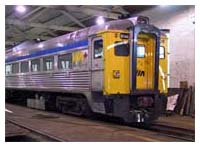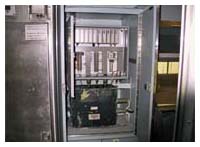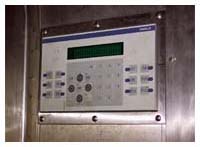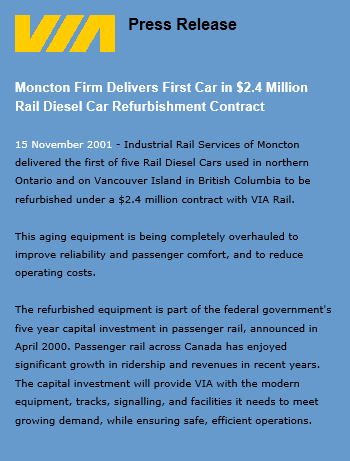
![]() In 1912 Edward G. Budd, the founder of the Budd Company, discovered how to press stainless steel sheet into complex shapes and to weld these components into strong self-supporting structures.
In 1912 Edward G. Budd, the founder of the Budd Company, discovered how to press stainless steel sheet into complex shapes and to weld these components into strong self-supporting structures.
This resulted in the production of the world's first stainless steel rail passenger cars.
After fifteen years experience in the construction of these cars the Budd Company introduced the first Rail Diesel Car (RDC) in 1949. The RDC is a self-propelled stainless steel passenger coach powered by two diesel engines. Because of its box-girder, shot welded stainless steel construction, a Budd RDC loaded with fuel, water, and sand, weighs about the same as a standard lightweight steel passenger coach. The RDC was designed for use in branch line, commuter, suburban, and supplementary main line service.
Between 1950 and the mid-1980s Budd became North America's second-largest producer of railroad passenger cars. In 1978 Budd was acquired by Thyssen AG of Germany and withdrew from rail passenger car construction to concentrate on automotive industry products.
![]() Budd RDCs don't have an engine compartment within the body. There are two diesel engines located beneath the floor in a protective housing. These engines are connected mechanically to the inside wheel pair on each truck though a "torque converter".
Budd RDCs don't have an engine compartment within the body. There are two diesel engines located beneath the floor in a protective housing. These engines are connected mechanically to the inside wheel pair on each truck though a "torque converter".
An RDC is capable of operating with only one engine, if necessary. With available power thereby reduced, only 45 miles-per-hour may be obtained, not the top speed of 79 miles-per-hour.
The RDC has a vestibule at each end with steps on each side for boarding the vehicle just as in a standard passenger car. In addition, an engineers control stand is provided in each vestibule. This eliminates the necessity to "turn" the car when reversing directions. The operator simply switches ends. It is possible to "MU" (Multiple Unit) several RDCs into a train. The engineer controls all cars in the train from the vestibule on either end of the train.
The original "coach" type RDC, known as an RDC-1, evolved into the RDC-2, RDC-3, and the RDC-4. An RDC-2 looks like a Combine. It carries passengers but also has a baggage compartment with an additional external baggage door on each side. The RDC-3 was a combination of coach, baggage, and Railway Post Office, with two additional external doors per side. The RDC-4 was a baggage and Railway Post Office car that did not provide passenger seating.
 VIA Rail, Canada's version of Amtrak, operates RDCs between Sudbury and White River, Ontario, and also on the Esquimalt & Nanaimo Railway of Vancouver Island. (Vancouver Island service was discontinued in 2011.)
VIA Rail, Canada's version of Amtrak, operates RDCs between Sudbury and White River, Ontario, and also on the Esquimalt & Nanaimo Railway of Vancouver Island. (Vancouver Island service was discontinued in 2011.)
Budd RDCs are excellent vehicles for the service requirements on these two lines but over the passing years VIA's RDC fleet has deteriorated becoming unreliable and expensive to maintain.
Beginning June 2001 Industrial Rail Services of Moncton, New Brunswick, began to refurbish five VIA Rail RDCs. Work is to include overhaul of all mechanical systems, engines, transmissions, air conditioning, generators, motors, trucks, and the car interior, including carpets, upholstery, and seats. VIA leased an additional RDC so that work which is performed one-car-at-a-time in Moncton will not disrupt train services.
The first refurbished RDC was completed on 15 Nov 2001, the second in February 2002. The cost for this work will be 2.4 million dollars.
 VIA 6148 was built by the Budd Company in 1957 as Canadian Pacific Railway number 9114, an RDC-2. Later the baggage section was removed being filled with passenger seats and the unit classified as RDC-2M. It can hold 71 passengers and has a snack bar and wheelchair accessible washroom.
VIA 6148 was built by the Budd Company in 1957 as Canadian Pacific Railway number 9114, an RDC-2. Later the baggage section was removed being filled with passenger seats and the unit classified as RDC-2M. It can hold 71 passengers and has a snack bar and wheelchair accessible washroom.
After refurbishment in Moncton VIA 6148 saw service in northern Ontario before arriving at the Esquimalt & Nanaimo's Victoria roundhouse in late August 2002. Externally it appears the same except for a modified paint scheme. The letter board above the windows now sports a blue band of paint. The VIA Rail Canada flag logo has also been added on the sides. Large black VIA lettering appears on the end doors.
 Internally the story is different. Entering the car the first thing a passenger notices is the drab grey-green colour scheme. There are new carpets and upholstery but this same grey-green paint was applied over the seat-back snack trays. This looks shoddy as it is already chipping and peeling in places.
Internally the story is different. Entering the car the first thing a passenger notices is the drab grey-green colour scheme. There are new carpets and upholstery but this same grey-green paint was applied over the seat-back snack trays. This looks shoddy as it is already chipping and peeling in places.
Immediately behind the engineer's control stand in the vestibule, about five feet above the floor, a push button computer control panel was added. The closet next to the passenger compartment contains a computer system named the EPPC-100 Engine Controller. This system monitors all critical engine and transmission functions such as temperature, pressure, engine speed, and track speed. It controls all engine and transmission functions, and has alarm and engine shut-down functions in the event of any detected defect. It also has the ability to cause the drive system to "shift". A typical automobile transmission can shift three or four times but the RDC can shift only once. (They seldom, if ever, get out of first on the E&N!) Both of VIA 6148's transmissions were replaced during the overhaul in Moncton.
It would be interesting to know more about the computer system installed by Industrial Rail Services but they were unwilling to provide any information.
Industrial Rail Services
95 Foundry Street Box 1
Moncton New Brunswick E1C 5H7
(506) 855-6630
Fax (506) 853-0510
Email wmattice@fundy.net



